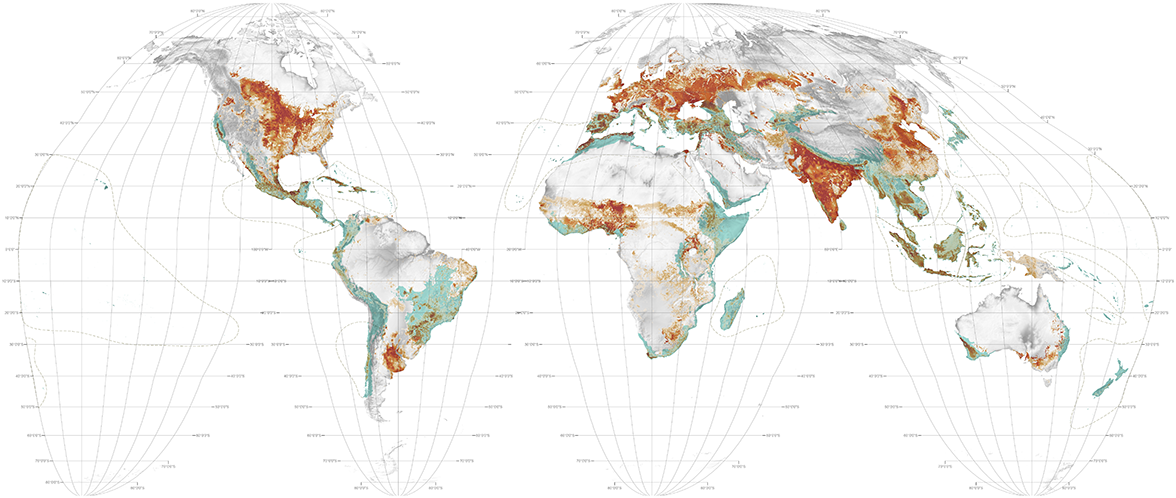
| Croplands (2000) | |
 | |
| 1 >>>>>> 100% agricultural landuse | |
| Hotspots |
Agriculture gave birth to cities, which in turn gave birth to larger populations, which in turn demand more food. Consequently, the frontier of agriculture has continually advanced. We are possibly now in the last century of this 10,000-year growth phenomenon. The aim is to feed a peak global population of circa 10 billion people this century, most of whom will live in cities, with the expectation that thereafter global population will stabilize, if not decline. 1 To do this it is commonly agreed that we will need to at least double our current global agricultural yield. 2
According to Future Directions International croplands cover 1.53 billion hectares while pasture for animal grazing cover another 3.38 billion hectares, a total of 38% of the earth's ice-free land. 3 Agriculture has already converted 70% of the world's grassland, 50% of the savanna, 45% of the temperate deciduous forest, and 27% of the tropical forest biome. Theoretically, some 2.7 billion hectares of land with potential for crop production remain. 4 Assuming all this land is under production by 2100 (as will be necessary to feed a global population of circa 10 billion) it would leave very close to 50% of the earth's ice free land for other critical functions such as carbon sequestration, evapotranspiration and biodiversity.
However, from this 50% we must subtract the world's existing deserts and land which is desertifying. Subtracting the deserts (which are about 33% of the earth's surface) leaves coincidentally 17% of the earth's ice-free terrestrial surface, exactly the amount of land the Convention on Biological Diversity says should be protected. The question then is whether the earth system can function in a stable manner with only 17% of its terrestrial area not turned over to monocultures.
Most current agricultural expansion is replacing forests in the tropics, where, from a global perspective the long-term costs far outweigh the short-term benefits. 5 Covering 7% of global terrestrial area the tropical rainforests are the planet's primary lungs and home to 50% of all living things including vast numbers of indigenous people who rely on the forests for their survival.
Agriculture's high yields since the mid-20th century are due to improved crop varieties and primarily the cheap mass production of industrial fertilizers and pesticides Whilst having spectacularly boosted yields, the buildup of nitrogen and phosphate run-off has caused extensive eutrophication of inland waterways and (over 500) 'dead zones' in the world's oceans. 6 Regardless, the United Nation's Food and Agriculture Organization predicts global fertilizer (nitrogen, potash and potassium) use will top 200 million tons by 2018. 7
Solutions to the adverse side effects of agriculture relate to halting further agricultural expansion and simultaneously increasing cropping efficiency, shifting diets to lower meat consumption, reducing food waste (variously thought to be 30-50%), organic soil remedies, new crop varieties and the global development of agricultural economics which include and incentivize the protection of ecosystem services. Against the complicated backdrop of increasing tension between global biodiversity and global food production, (see Foodscape) it is also important to bear in mind that almost 800 million people, roughly one in nine are presently hungry and mal-nourished 8
1 United Nations, Department of Economic and Social Affairs, Population Division, World Population Prospects: The 2015 Revision, Key Findings and Advance Tables (2015). Available at https://esa.un.org/unpd/wpp/Publications/.
2 Jonathan A. Foley, et al., "Solutions for a cultivated planet," Nature 478 (2011): 337-342.
3 Future Directions International, "The Future Prospects for Global Arable Land," http://www.futuredirections.org.au/publication/the-future-prospects-for-global-arable-land/ (accessed June 24, 2016).
4 ibid.
5 Foley, "Solutions for a cultivated planet."
6 Oliver Morton, The Planet Remade: How Geoengineering Could Change the World (Princeton University Press, 2015), 198.
7 Food and Agriculture Organization of the United Nations, "Fertilizer Use to Surpass 200 Million Tonnes in 2018," http://www.fao.org/news/story/en/item/277488/icode/ (accessed September 6, 2016).
8 The Economist Intelligence Unit, "Global Food Security Index 2016: An Annual Measure of the State of Global Food Security," http://foodsecurityindex.eiu.com/ (accessed June 24, 2016).
1. Croplands
Navin Ramankutty, et al., "Farming the Planet: 1. Geographic Distribution of Global Agricultural Lands in the Year 2000," Global Biogeochemical Cycles 22, no. 1 (2008). Dataset: "Global Agricultural Lands: Croplands, 2000", developed by Navin Ramankutty, et al. (2010), distributed by the NASA Socioeconomic Data and Applications Center (SEDAC) of the Center for International Earth Science Information Network (CIESIN) / Columbia University, http://sedac.ciesin.columbia.edu/data/set/aglands-croplands-2000 (accessed October 4, 2014).
2. Hotspots
Critical Ecosystem Partnership Fund, "The Biodiversity Hotspots," http://www.cepf.net/resources/hotspots/pages/default.aspx (accessed July 1, 2014). Data made available under the Creative Commons BY-SA 4.0 License: https://creativecommons.org/licenses/by-sa/4.0/legalcode.